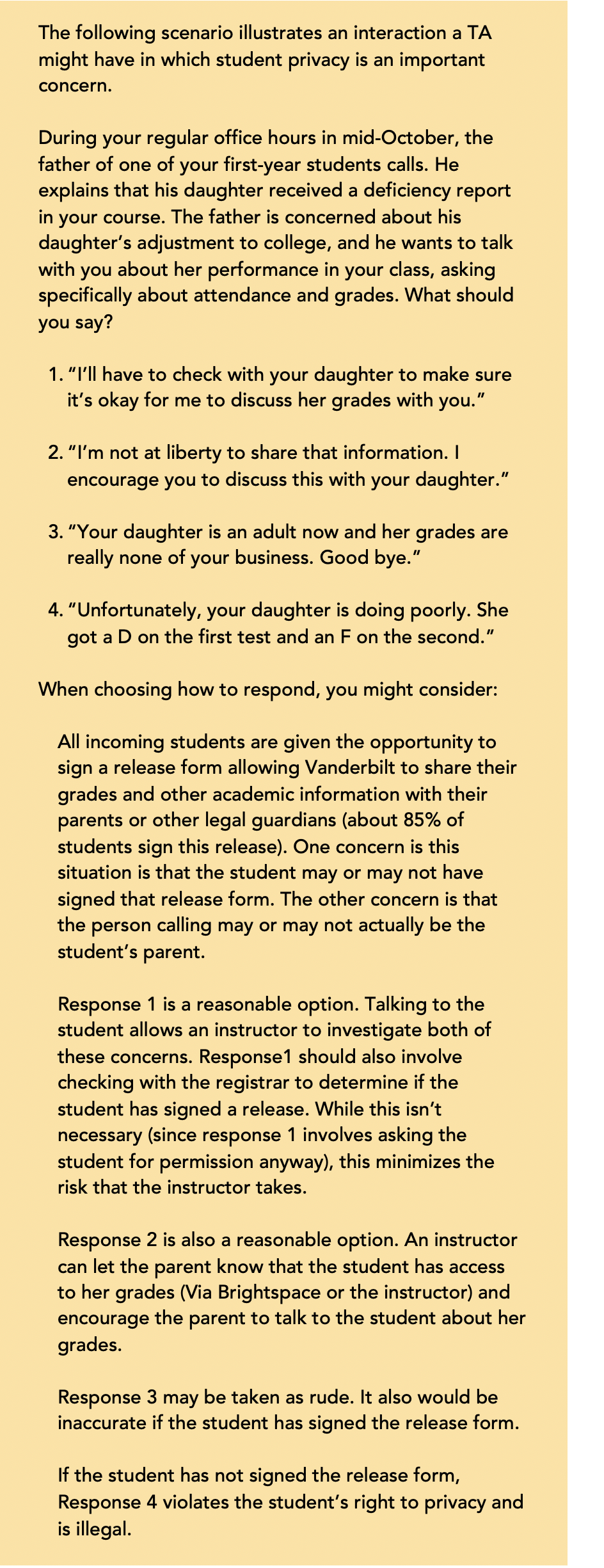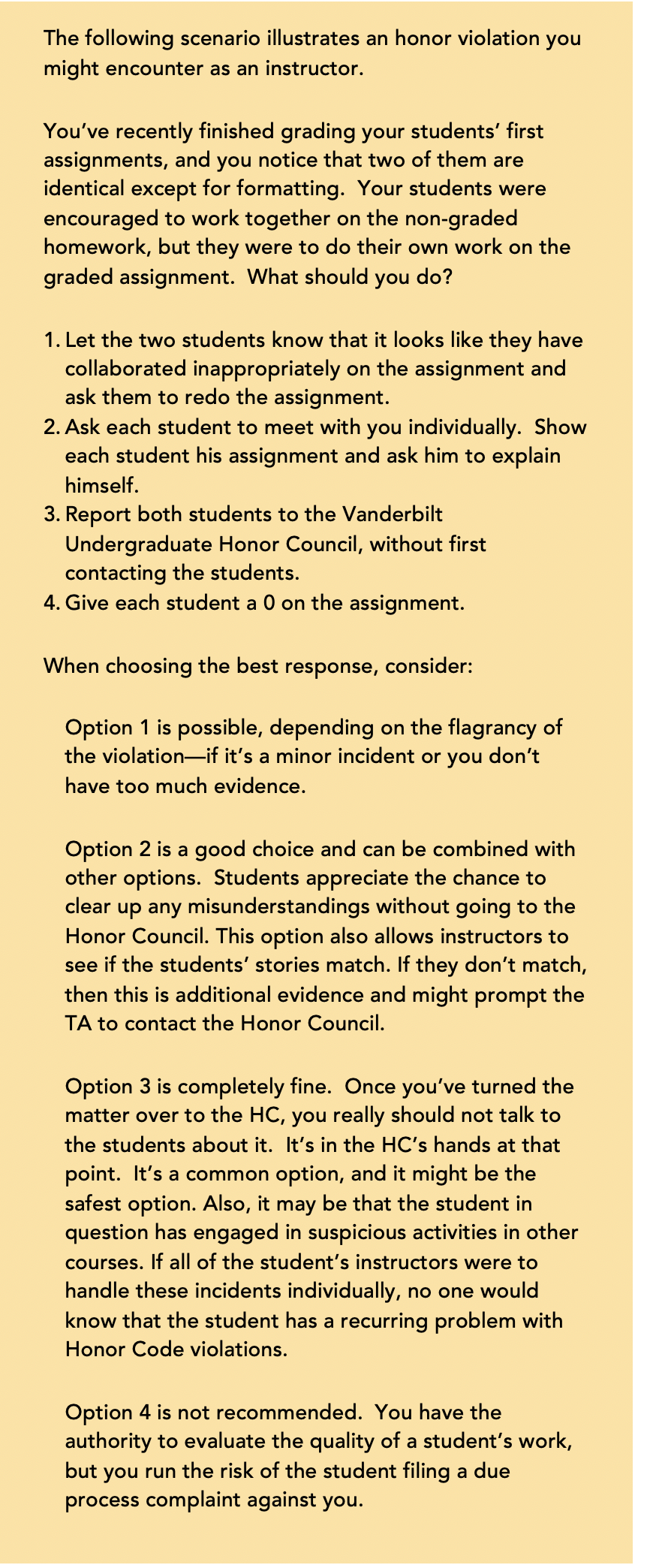International Instructor Guide
Faculty and graduate student teaching assistants from different parts of the world often find much that is unexpected when they teach in an U.S. classroom. Teaching in U.S. universities (and at Vanderbilt, in particular) can be quite different from teaching in other countries, especially in terms of expectations for both teachers and students. Understanding these differences can help us to improve our teaching and prevent misunderstandings in the classroom.
- Characteristics of the U.S. classroom
- Things to know about Vanderbilt
- International Instructor Issues in Teaching
- Important teaching skills
- Additional resources
Characteristics of the U.S. classroom
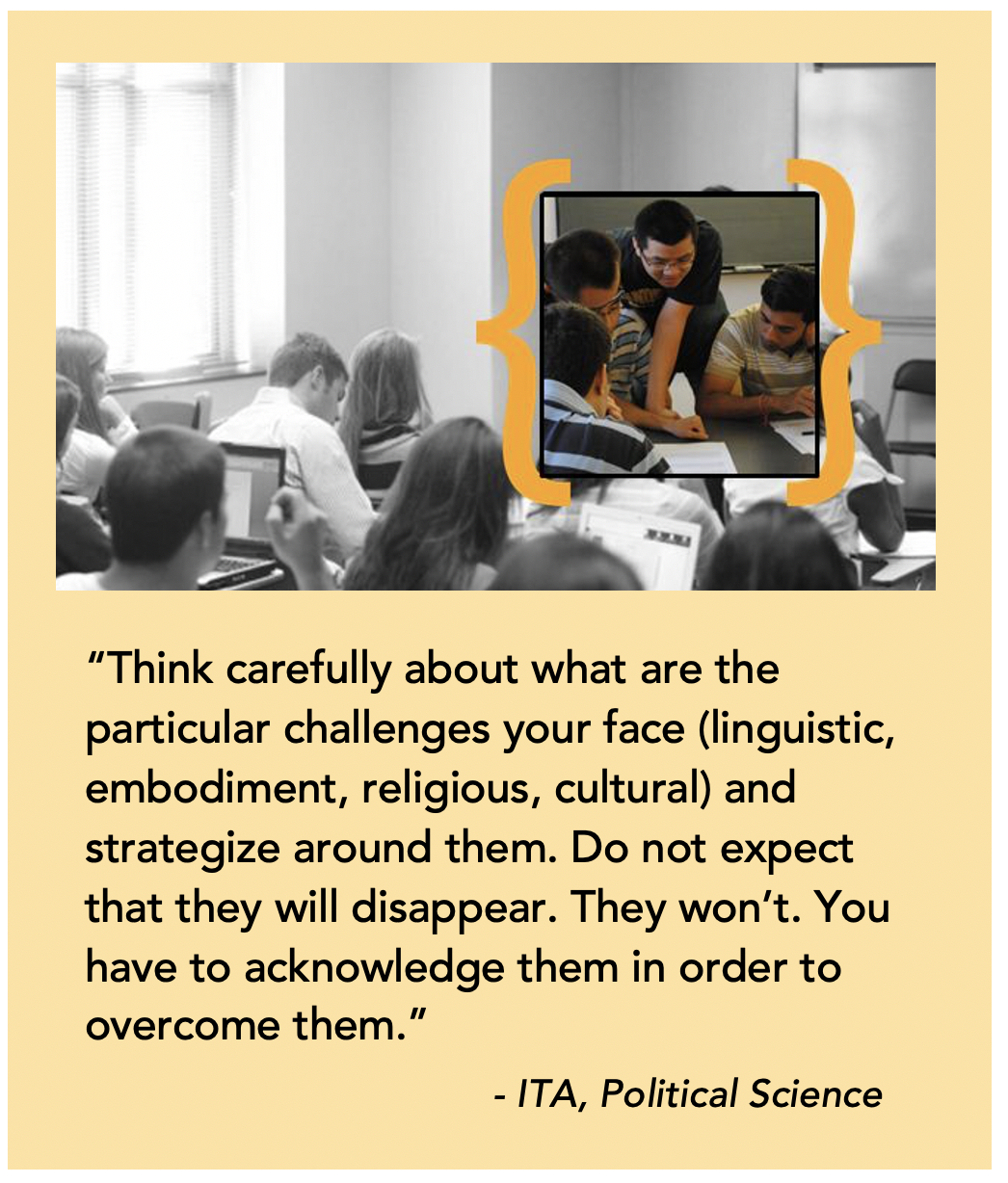 The U.S. university system commonly consists of four years of study at a post-secondary institution. These years of study are at the ‘undergraduate’ level and are commonly called freshman, sophomore, junior and senior years, though you might sometimes hear freshman referred to as ‘first years.”
The U.S. university system commonly consists of four years of study at a post-secondary institution. These years of study are at the ‘undergraduate’ level and are commonly called freshman, sophomore, junior and senior years, though you might sometimes hear freshman referred to as ‘first years.”
In the U.S., university students may come from very different backgrounds and may take courses for very different reasons. In some countries, university students take courses only within their chosen major. In the U.S., however, universities value a liberal arts tradition that emphasizes study across many disciplines. Students therefore take courses in a variety of disciplines to fulfill general education requirements in addition to taking courses within their major. Because of their varied backgrounds and varied reasons for taking a course, differences among students can be pronounced, especially in introductory courses.
Typical high school preparation
Generally, at the high school level, U.S. students take a broad variety of classes without special emphasis in any particular subject. Students are required to take a certain minimum number of mandatory subjects, but may choose additional subjects (“electives”) to fill out their required hours of learning. Mandatory subjects typically include: science, math, history, English, and social sciences.
The families of U.S. undergraduates pay large amounts of money for costs associated with college (tuition, supplies, room and board). The total costs for a Vanderbilt undergraduate for the academic year 2019-20 was $58,340.
Student privacy
The Family Educational Rights and Privacy Act (FERPA) protects the privacy of students’ academic records. Grades and other academic information are to be given to individual students only, and they alone can approve the sharing of their academic information with third parties. All incoming students are given the opportunity to sign a release form allowing Vanderbilt to share their academic information with their parents or legal guardians. An instructor cannot discuss a student’s grades with that student’s parents without first confirming that the student has signed the release. Please note that sending grades to students via email is not considered secure enough for FERPA. Instructors should make students aware of this and request permission to send grades by email. If the students grant the instructor permission to send grades via email, then the instructor may do so. Another option is to post grades to Blackboard, which is considered more secure than email.
General characteristics of the U.S. classroom
Students ask questions and share opinions
In general, the learning environment in the United States and at Vanderbilt is highly interactive, and teacher-student relations and communications tend to be relatively informal. As a result, U.S. students ask more questions and give their opinions more freely than in many other higher-educational systems.
Teachers encourage students to have independent opinions and to make the course relevant to their own interests and goals. Students are often casual with teachers, especially those they like and respect. They also appreciate the chance to discuss viewpoints that do not necessarily agree with the teacher’s ideas.
The classroom environment tends to be informal.
Although there are many differences in social, economic, and educational levels in the U.S., there is an ideal of equality that runs through social relationships. The notion of equality leads students to be quite informal in their general behaviors and relationships with others.
The informality of dress, posture, and speech, especially the common use of the first name, can be shocking to some international students, staff, and faculty. It is not uncommon for students to use slang in the classroom, or as a part of their ordinary conversations with instructors or other students. This list can help you understand some of the common slang you might hear your students using.
There is also a vernacular that is specific to Vanderbilt that might be helpful to know. This said, students should respect whatever names and honorifics their instructors request them to use, in addition to any professionalism or decorum you believe necessary for classroom civility. Please be direct in asking them to honor this language, or better, open a dialogue with them about cultural differences and how you might create a classroom culture than honors everyone’s expectations and needs.
Many international students and staff comment on informal dress on U.S., which is generally very casual. You will see students going to class in shorts and t-shirts. Instructors’ clothing may also be informal, although it is typically more formal than that of the students.
Students expect instructors to appear friendly and open to interaction. Students in the U.S. respond well to “immediacy cues,” or verbal and nonverbal communication that reduce the psychological and physical distance between instructors and students (LeGros and Faez, 2012). U.S. students tend to respond well to instructors who make eye contact, smile and nod, or use other nonverbal means to indicate that they are listening carefully to the student (Teven and Hanson, 2004). Students also tend to respond well to positive verbal cues, such as inviting students to speak or verbally rewarding students’ contributions (Neuliep, 1997). Students can perceive instructors who do not exhibit these cues as being unfriendly or uninterested in the class or the students–and can therefore be less willing to learn (Fitch and Morgan, 2003).
In addition, feedback in the U.S. tends to be affirmative and non-authoritarian. Although it’s important to correct students’ misperceptions, instructors often do so by noting something positive before giving the corrective feedback. There’s some evidence (Cohen, Steele, & Ross, 1999) that providing so-called “wise feedback” can increase student success. This feedback consists of an affirmation that a student can meet the high standards of a course along with specific, constructive suggestions to help the student meet those standards.
Instructors strive to make classroom communication clearly structured and accessible to all students. Instructors in the U.S. tend to use “low context” communication, or language that does not assume a high level of knowledge about the subject (Eland, 2001; LeGros and Faez, 2012). Instructors assume responsibility for student understanding; failure of a student to understand is often perceived as the instructor’s failure to be clear rather than the student’s failure. This feature of the U.S. classroom results in part from the varied backgrounds of U.S. students. It can be dramatically different from classroom practices in some other cultures where high context communication assumes that listeners bring a similar set of knowledge and experience to the classroom.
Instructors in the U.S. also tend to use language and nonverbal cues that are structured to promote easy understanding (Chaudron and Richards, 1986). Lectures in the U.S. classroom are often peppered with discourse markers that alert students to the expected progression of the class period as well as the most important elements of the lecture. For example, an instructor might say something like, “Today, we are going to begin by reviewing material from the last class; we are going to highlight the three most important elements of your reading; and we are going to briefly discuss your homework assignment.” This type of structure differs dramatically from that observed in some cultures, but can be very helpful when working with U.S. students (Tyler, 1992; Williams, 1992).
Students expect multiple assignments throughout a semester.
In some countries, the only “assignments” given to university students are end-of-semester final exams; students are therefore expected to manage their own studies during the semester. In U.S. college courses, students are typically given more structured activities and assignments during the semester, both to help the students manage their studies and to give students and instructors ongoing information about student learning.
Things to know about Vanderbilt
You may see basic quick facts about Vanderbilt’s enrollment, student demographics, and other information here, One important piece of information is that Vanderbilt enrolls over 12,000 students from all 50 U.S. states and over 90 foreign countries in four undergraduate and six graduate and professional schools. Vanderbilt undergraduates account for over half of the total student population. Vanderbilt students are a increasingly diverse group, representing a wide array of backgrounds, identities, and ideologies. It therefore can be challenging to grasp all of the nuances of Vanderbilt’s student life. However, because of its growing diversity, Vanderbilt students are accustomed to living and working on a dynamic campus.
All Vanderbilt students are governed by the Honor System of Vanderbilt University. If an instructor believes a student has violated the Honor System, then the instructor is obligated to either issue a warning to the student or report the violation to the Honor Council. Instructors are not allowed to punish students themselves. Syllabi and other course communications should make clear to students how the Honor System applies in a particular course. See the Undergraduate Honor Council web site for sample syllabi statement and other advice on this topic.
Most of the cases that the that Honor Council investigates involve plagiarism or cheating. Plagiarism cases are usually more straight-forward than cheating cases – about 80% of these can be detected with a simple Google search.
The purpose of the Honor Code is not just to punish wrongdoing. It’s primarily about educating students about academic integrity. That’s why students who are found guilty usually aren’t expelled from Vanderbilt. They may receive an F in the course (the minimum penalty in most cases), but they’re given a second chance. It’s very important to prevent situations like this through clear communication of expectations for student work.
Resources for students in distress
Listening to a student in distress is important. The student might have serious problems that require professional help. An instructor or TA should not rule out the possibility that the student has a more serious problem without first listening to the student. If the student says anything about hurting him/herself or not being able to go on, then you should seek immediate assistance, either by walking the student to a hospital or to the University Counseling Center (UCC) or by calling the UCC.
Since the UCC can help students with a variety of difficulties (poor study skills, learning disabilities, emotional and mental health issues), it is a useful place to send student in distress. Every fulltime Vanderbilt student can receive counseling at the UCC for free.
Faculty duties and responsibilities
Roles and responsibilities of faculty instructors at Vanderbilt may vary by appointment and context, but generally are outlined in the Faculty Manual, which you may find here. You may give special attention to Part III on University Principles and Policies, which discusses, among other principles, the Honor System, Privacy Rights of Students, Consensual and Familial Interpersonal Relationships, and Nondiscrimination, to name a few. Generally, as a faculty instructor, your responsibilities include all elements of teaching, including but not limited to the following:
- Designing and conducting courses
- Providing course plans and schedules
- Planning and facilitating class dialogue
- Assessing and communicating evaluations of student work
- Directing students to necessary resources
- Holding office hours
- Maintaining clear and complete records
- Coordinating the work of Teaching Assistants (if you have them)
- Supporting all students in their learning regardless of background
You may also consult the chair of your department or program, the Deans of your school, or the Provost’s office for further guidance on specific issues or circumstances.
TA duties and responsibilities
Roles and responsibilities of teaching assistants at Vanderbilt vary greatly from department to department. While your specific duties might differ from this list, here is an overview of some of the most common responsibilities a TA might have:
- Reinforcing basic lecture material through discussion sessions, introductory lectures, or lab sessions
- Providing exam review assistance
- Holding office hours
- Directing students to additional resources
- Answering questions
- Assessing student work
- Maintaining clear and complete records
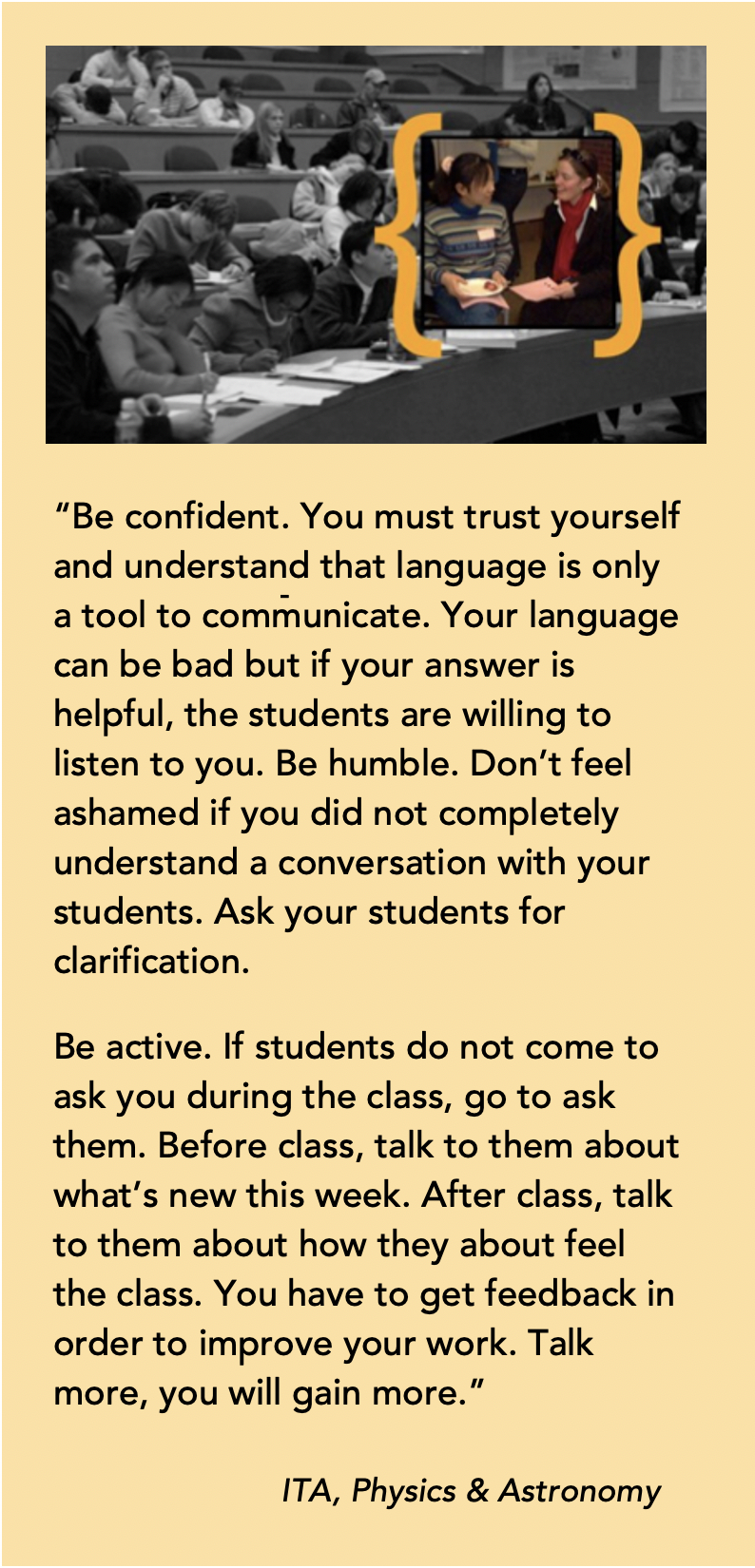 TAs are usually under the direct supervision of the professor of record for the course in which the TA is assigned. It’s important to think carefully about the role you’re being asked to perform and to clarify any questions you have with the professor of record. You can use this expanded list: Questions TAs Might Ask Their Supervisors as a basis to clarify your roles and responsibilities with the professor you’re working with before the course begins, but you might start with:
TAs are usually under the direct supervision of the professor of record for the course in which the TA is assigned. It’s important to think carefully about the role you’re being asked to perform and to clarify any questions you have with the professor of record. You can use this expanded list: Questions TAs Might Ask Their Supervisors as a basis to clarify your roles and responsibilities with the professor you’re working with before the course begins, but you might start with:
- What are the specific tasks you wish me to undertake?
- Do you want me to attend the lectures in the course?
- Are there solutions for the problems
(or specific issues to look for in grading papers) or will I be expected to generate them myself? - Which specific dates on the course schedule affect me and how much time should I plan in order to perform my duties?
Most departments have general guidelines for the number of hours you’ll be expected to spend on TA duties including class preparation, in-class teaching and office hours for students. Ask for clarification if these guidelines aren’t provided.
International Instructor Issues in Teaching
Grading
Grading can be a source of stress for instructors of all ranks. How do you know if you’re being fair in your assessment of student work? What do you do when a student questions a grade? How will you find the time to read all of those student essays or grade those problem sets? You can establish grading criteria and rubrics, provide written feedback to students, make grading more time efficient, and talk to students about grades. To overcome this challenge, you can read the CFT’s Teaching Guide on Grading Student Work. More importantly, especially if you have instructor responsibilities, consider your assessment plan more generally to ensure it conforms to your goals for the course and that you are assessing student learning in ways that are equitable, generative, and rigorous. To begin this process, please consult the CFT’s Teaching Guide on Assessing Student Learning.
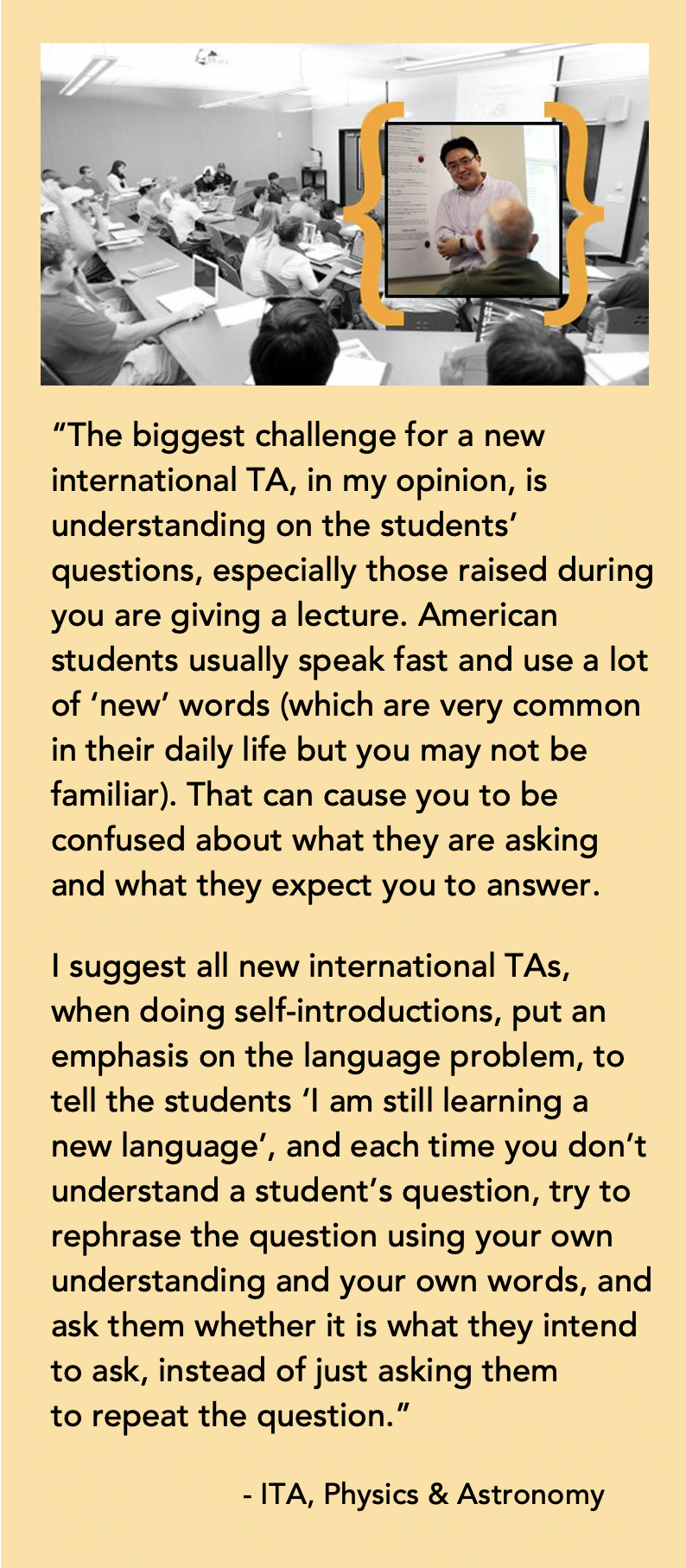 Talking about your command of English
Talking about your command of English
Early in the course, you should acknowledge that English is not your first language, and ask your students to let you know when you speak too quickly, quietly, or if students don’t understand something. Throughout the course, you might keep these tips in mind:
- When speaking, make eye contact with students in the class (which is not a norm in every culture). By doing so, you will be able to discern who looks confused and address questions as they arise.
- Face students while speaking. It can be difficult to remember to turn around – especially in the case of blackboard work – but you might get into the habit of writing the information on the board first, and then turning around and speaking.
- Use lots of demonstrations, props, and illustrations to supplement instruction.
- Write key words on blackboard/overhead/PowerPoint, particularly when your pronunciation of the word is unclear. Hand-outs prepared ahead of time can help students follow instruction.
Maintaining proper boundaries
Sexual harassment
Sexual harassment is any unwanted, unsolicited, or undesired attention of a sexual nature and is a violation of federal law. The Title IX Equal Access Office provides resources for victims of sexual harassment and is responsible for investigating claims of sexual harassment at Vanderbilt.
If a student reports being sexually harassed to an instructor, the instructor has a responsibility to make sure the incident is reported to the Title IX Equal Access Office. The instructor may opt to encourage the student to report the incident to Title IX, then follow up with Title IX to make sure the incident has been reported. Alternatively, the instructor may report the incident to Title IX directly.
Consensual relations
Consensual sexual relationships are prohibited between a student and any instructor who teaches that student. Since an instructor is in a position of power over a student, any relationship would either be a conflict of interest or give the impression of a conflict of interest. To avoid the appearance of a conflict of interest, instructors are advised to keep their office doors open when consulting with students.
Important teaching skills
Speaking with confidence
One of the most important things you can do to establish a good tone in your class is to speak with confidence. Some tips that may help:
- Remember that the students want you to do well. They have chosen to come to your class to learn and they want you to be successful.
- Remember to try and conceal any signs of nervousness or anxiety. Much of the nervousness you feel is not usually seen by others.
- Concentrate on your topic. Come to class prepared with an outline of the lecture. This should not be a written speech, but an outline that you can freely speak from rather than read from.
- Think positively instead of focusing on your fear. Positive thinking is a step in overcoming nervousness.
- Make strong eye contact with your students and use good body language to convey your confidence.
Asking & answering questions
Dealing with student questions is a recurring challenge for international instructors in the classroom, lab, and during office hours. Knowing certain phrases that are often used to used in structuring a question can help you identify students’ questions and to ask questions to students.
Asking questions
Here are some useful opening expressions that lead up to questions:
- I wonder if you could tell me….(I was wondering if you….)
- I’d like to know….
Often, when you ask a question, you may not get enough information in reply, or not get the answer that you intended/expected. This result means you will have to ask for additional information or to ask your question in a different way (rephrase it) so that it is better understood. You could say:
- Could you tell me more about….?
- Would you mind telling me more about….?
- I’d like to know more about….
- Something else I was wondering about was….
- Sorry, that’s not really what I mean. What I’d like to know is…
When you are asking a question, it is important to give students 7-10 seconds to answer. You may have to restate the question or offer other prompts or tips in order to direct them.
You should ask your students questions throughout your lesson. Don’t wait until the end of your lesson to learn if your students have understood the topic you’re teaching. Pause at the end of each main idea and ask them a few questions to see if they can apply what you’ve taught them. Ask them to provide an example, to work a sample problem or to supply some missing information.
Answering questions.
There are a number of conventions that can be useful in answering questions. For example, you may need to delay answering a question while you think for a brief moment or look at your notes, etc. Here are some expressions for when you need to delay your response:
- Well, let me see…
- Well now…
- Oh, let me think for a moment….
- That’s a very interesting question.
If you do not know the answer, you may want to say:
- I’m not sure. I’ll have to check…
- I’m not really sure.
- I can’t answer that one right now.
- I’m sorry, I really don’t know.
- Let me get back to you (on that one).
Or, if you think the question is not directly on topic:
- That’s something I’d rather not talk about just now.
- I wonder if you’d hold that question for later?
- Let’s go back to _____
- To get back to our initial question, …
Or if you do not understand the question:
- I’m sorry, but would you mind repeating that?
- Excuse me, but I didn’t quite follow that.
- Would you say that again in a different way?
- Are you asking me to explain ______?
Additional resources for asking questions:
- Academic Spoken English. This search engine helps you to look up phrases used in spoken academic English based on the wording, the speaker, or the type of transcript involved.
Office hours
Holding office hours is an important responsibility for many instructors at Vanderbilt, yet many international instructors are unfamiliar with this type of instructor-student interaction. Office hours are generally held weekly in 1 or 2 hour blocks of time when class does not meet. You should announce your office hours at the first class meeting, and repeat them throughout the semester. You can also request that students make an appointment to see you during office hours once or twice during the semester.
The office hours tips below are from Teaching Matters: Skills and Strategies for International Teaching Assistants, which is available at the Peabody library.
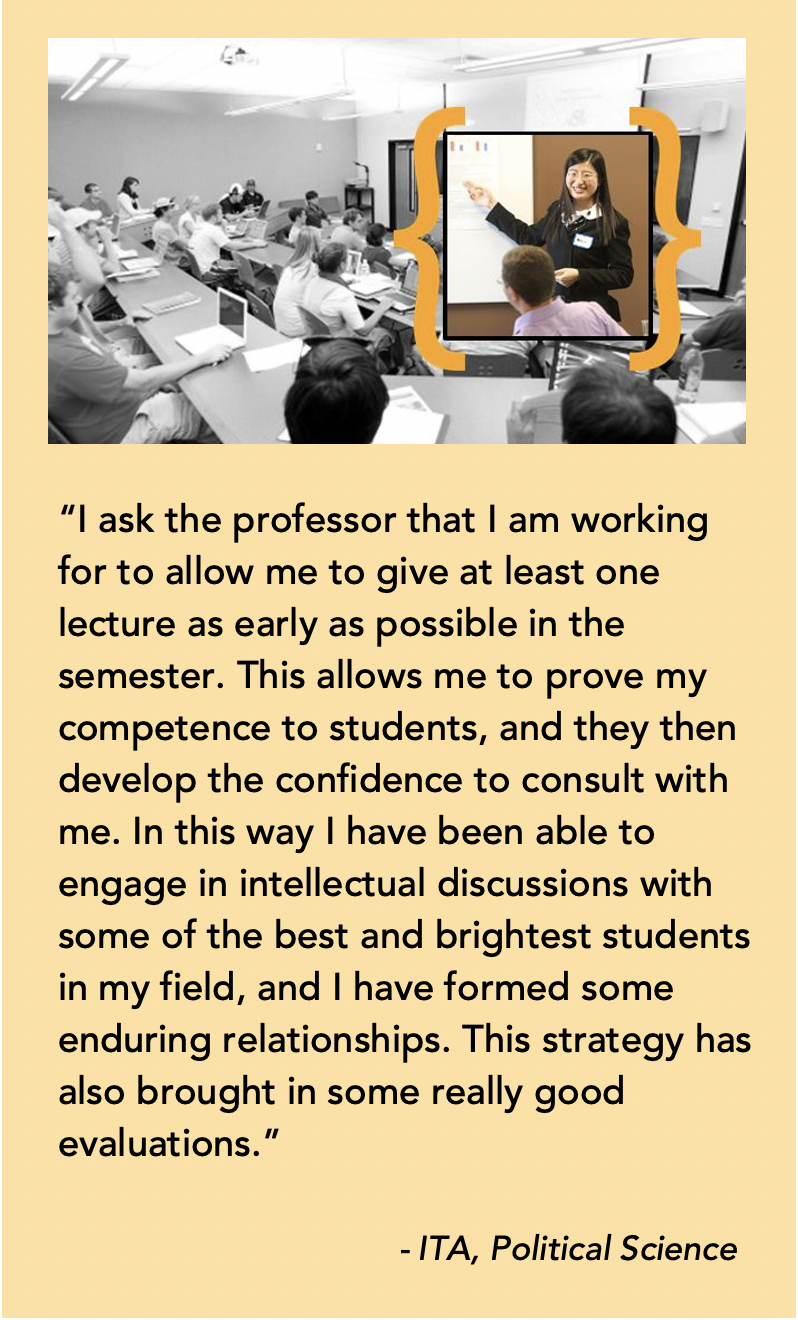 Greeting student when they arrive at your office
Greeting student when they arrive at your office
Make the student feel welcome by using eye contact, smiling, gesturing toward a chair, and appearing eager. As you get to know students, your openers can be adjusted to their personalities.
- Hello. Would you like to see me?
- Hi, _____ (name). Come in and have a seat.
- Hi, _____ (name). Have a seat. What can I do for you?
Engaging in chitchat and getting to the point
Briefly engage in chitchat to help the student feel welcome and comfortable. But generally, this type of exchange is brief and you may need to direct students to the point of their visit. Usually, it is best not to assume that you know why the student has come to see you unless an appointment was set up for a specific purpose.
- So, what are you here to talk about?
- Okay, let’s see what you’ve got.
- Do you want to talk about the homework?
- Let’s deal with that question first.
- There’s a lot to go over. Let’s get started, okay?
- You wanted to know about ___. Do you want me to talk about the basics?
- Would you like to try working through a problem? Would that help?
Using pencil and paper
As you discuss a topic with the student, writing down unclear points can help to resolve communication problems. You can then give the paper to the student to take with him/her. You can also draw a diagram on paper can clarify a concept, or ask the student to do so to demonstrate his or her understanding.
Expressing disagreement/saying “no” politely
Sometimes students want to question a grade you have assigned. Or a disagreement might arise when a student cannot solve a problem and feels frustrated by the course material. Control these situations by acknowledging the student’s viewpoint while maintaining your position. Use polite phrases so that “no” doesn’t sound so strong. Present good reasons for your decision so the student will understand your point of view. If the disagreement is serious, or the problem cannot be resolved, it may be best to terminate the meeting. Reschedule for a later time when the student has had a chance to think about what the two of you have discussed. Remain calm, even if the student is angry or begins to cry. Politely bring the meeting to a close.
- I can see your point, but …
- Yes, but on the other hand …
- I really wouldn’t put it that way, because …
- I’m not sure why you chose …
- I think you’ve missed one important fact, which is …
- I know this isn’t what you want to hear, but …
- I’m sorry you don’t accept my decision, but I have to stand by it.
- Okay, let’s stop for now. If you still feel this way in a couple of days, we can talk again.
Bringing closure
Close the meeting by guiding the discussion to an end.
- Do you think we’ve covered everything?
- Why don’t you look it over and come back next week if you have questions?
- Let me know if you need any more help.
- I’m here twice a week, so you can come back on _____.
- Think about it for a day or so; then we’ll talk again.
- Okay, then. So I’ll see you in class.
- Maybe if you have any other questions about the test, you can come see me next week.
Additional resources for office hours:
- Using Office Hours Effectively. This article provides more information about why students will visit you during office hours and read some tips for interacting with students.
Additional resources
In your department:
- Talk to experienced instructors in your field of study. They can be great sources for advice about teaching. You can talk with American or international TAs or faculty to get practical help with many of your questions about teaching. Most will be glad to help because they remember what it was like to teach for the first time.
- Observe others who are teaching the same or similar subject as you are. Ask another TA or faculty member if you can attend their class for several days. Take notes on how they present the material, deal with student questions and use visual aids. Model the good teaching practices that you observe.
- Ask questions of your supervising professor. Prepare your specific questions in advance and make an appointment to see your professor. Don’t be afraid to ask questions. Even your professor was a beginning teacher at some point in time.
On campus:
- International Student and Scholar Services has a range of programs and services for international faculty, students, and families.
- The Vanderbilt English Language Center offers the Effective Teaching Strategies for International Faculty Program that helps faculty who have a first language other than English hone their instructional skills for the US university classroom context.
- Center for Teaching consultants work individually with faculty and teaching assistants on any issue related to teaching – from preparing to teach your first class in the United States to applying recent research on learning to your classroom. To arrange an appointment with a consultant, contact us, call (615) 322-7290, or visit us at 1114 19th Avenue South, 3rd Floor.
Online:
- The Center for Global Education at UCLA has developed a website describing innovative programs to support international students.
In print:
- Althen, G. (2003). American Ways , 2nd ed. Yarmouth, ME: Intercultural Press.
- Chaudron, C and Richards, JC. (1986). The Effect of Discourse Markers on the Comprehension of Lectures. Applied Linguistics 7: 113-127.
- Derek Bok Center for Teaching and Learning (1993). Teaching in America (VIDEO). Harvard University.
- Eland, A. (2001). Intersection of Academics and Culture: The Academic Experience of International Graduate Students (Doctoral dissertation). University of Minnesota, Minneapolis, MN. Retrieved from ProQuest Dissertations and Theses Database.
- Fitch, F. and Morgan, S.E. (2003). “Not a Lick of English:” Constructing the ITA Identity through Student Narratives. Communication Education 52: 297-310.
- LeGros, N. and Faez, F. (2012). The Intersection Between Intercultural Competence and Teaching Behaviors: A Case of International Teaching Assistants. Journal on Excellence in College Teaching 23: 7-31.
- Neuliep, J.W. (1997). A Cross-Cultural Comparison of Teacher Immediacy in American and Japanese College Classrooms. Communication Research 24: 431-451.
- Sarkisian, E. (1997). Teaching American Students , Rev. ed. Cambridge: Harvard.
- Pica, T., G. Barnes, A. Finger. (1990). Teaching Matters: Skills and Strategies for International Teaching Assistants. Newbury House Publishers. Ch. 4.
- Teven, J.J. and Hanson, T.L. (2004) The Impact of Teacher Immediacy and Perceived Caring on Teacher Competence and Trustworthiness. Communication Quarterly 52: 39-53.
- Tyler, A. (1992). Discourse Structure and the Perception of Incoherence in International Teaching Assistants’ Spoken Discourse. TESOL Quarterly 26: 713-729.
- Wennerstrom, A. (1989). Techniques for Teachers: A Guide for Nonnative Speakers of English. The University of Michigan Press. pp. 129-145.]
- Williams, J. (1992). Planning, Discourse Marking, and the Comprehensibility of International Teaching Assistants. TESOL Quarterly 26: 693-711.
.
.
 This teaching guide is licensed under a Creative Commons Attribution-NonCommercial 4.0 International License
This teaching guide is licensed under a Creative Commons Attribution-NonCommercial 4.0 International License
